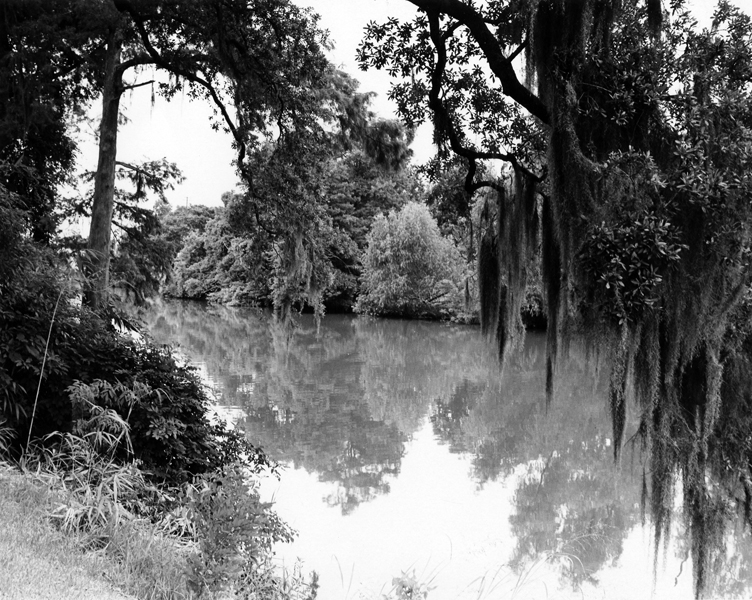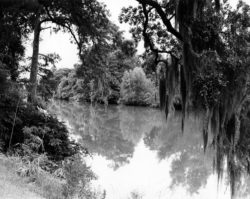Swamps in Literature, Film, and Folklore
Swamps have a unique place in the literature, film and folklore of Louisiana.

Courtesy of State Library of Louisiana
Bayou in Louisiana in the 1960s. Unidentified
While swamps are fairly common throughout the South, their representation in Louisiana has been somewhat unique. In southern culture, swamps are often represented as dangerous places, providing homes for deadly creatures. Particularly during the antebellum era, swamps typically represented an obstacle to the idealized image of the tamed landscape tended by the gentleman farmer. In accordance, most early southern depictions of swamps emphasized the dangers inherent in their uncontrollable wildness, and contributed to the myths that linked swamps with disease and even supernatural evil. While Louisianans acknowledge the menacing aspects of swamps, they also celebrate the beauty of the state’s bayous. Particularly in recent Louisiana literature, swamps are often depicted as shrinking remnants of a fading Cajun culture, to be preserved or, at the very least, mourned.
Swamps in Louisiana Folklore
With their traditional reliance on hunting, fishing, and trapping, many Cajuns depended on the swamp for survival—a reliance often revealed in their oral traditions, particularly folktales and legends. Despite the more positive associations that the swamp has generally had for Cajuns, many folktales are ghost stories and tales of boogiemen. The tale of the Honey Island swamp monster and the legend of the rougarou (a derivation of the loup garou or werewolf), for example, tap into the age-old formulation of the swamp as a repository for supernatural evils and elemental haunts. On the other hand, stories of the trickster rabbit Compair Lapin present a less threatening view of swamps, as can be seen in Alcée Fortier’s 1894 collection Louisiana Folk-Tales, in French Dialect and English Translation. As he relays these tales of the Compair Lapin, Fortier never uses the word “swamp,” preferring the term “bayou in the woods.” As this shift in terminology suggests, the stories present a somewhat idyllic representation of Cajun wetlands.
Similarly, slave narratives—published transcriptions of stories told by former slaves—present a somewhat ambivalent view of swamps. Solomon Northup, for example, notably recounts his escape through Louisiana’s “Great Pacoudrie Swamp” in his famous 1853 narrative Twelve Years a Slave. Fleeing the abuse of his owner, Northup travels through the “muck and mud” of the swamp, desperately seeking the home of a former, and more sympathetic, owner. Northup’s story echoes a general theme in slave narratives: slaves fear the swamp’s terrors, but posit it as a preferable alternative to a life in slavery. “Even in the heart of that dismal swamp,” Northup thinks to himself, “God had provided a refuge and a dwelling place for millions of living things.”
While grounded in historical fact, the evolving legend of Marie Laveau, New Orleans’s voodoo queen, also owes some of its power and intrigue to the swamp settings in which she carried out her ceremonies.Voodoo’s animistic and natural elements, combined with Laveau’s use of snakes in her ceremonies, link her with the dark and forbidding swamps surrounding New Orleans. Even now, some swamp tours promise glimpses into the “haunted” recesses of the Louisiana swamps, appealing to tourists’ fascination with the terror-filled swamps of folklore.
Swamps in Louisiana Literature
In Louisiana literature, perhaps the most famous evocation of swamps as places of beauty rather than of menace is Henry Wadsworth Longfellow’s 1847 poem “Evangeline.” Though Longfellow, a New Englander, had never actually seen the environment he describes, he imbues Louisiana swamps with a dark, romantic beauty, referring to them as “the forest primeval.” His poem has been adopted as part of Cajun culture, as evidenced by the parish and state parks, and numerous streets, bearing the name Evangeline. A rough contemporary of Longfellow’s, Louisiana humorist Henry Clay Lewis, represented the swamps differently in his 1859 short-story collection, Odd Leaves from the Life of a Louisiana Swamp Doctor. Writing in the tradition of the southwestern humorists, Lewis uses the primal swamp setting to skewer the aristocratic pretense of the planters around him.
The dark and menacing tropes surrounding the swamps made them a useful rhetorical tool for George Washington Cable, the noted fiction writer and activist for racial justice. Cable used the swamps surrounding New Orleans to great symbolic effect in short stories such as “Jean-ah Poquelin,” in which they signify cultural decay and stagnation. Yet in his 1880 novel, The Grandissimes, Cable uses the story of a slave’s escape into the swamp to critique the greater horrors of the society that enslaved him.
As ecological consciousness has evolved, and Louisiana’s swamps and wetlands have become increasingly threatened by development and pollution, contemporary writers have presented even more complex representations of swamps. In his Dave Robicheaux novels, detective writer James Lee Burke frequently links the swamps with a purer vision of Louisiana’s past, and connects their pollution with broader moral and systematic corruption. Similarly, Tim Gautreaux makes the swamp central in his novel The Next Step in the Dance, as his Louisiana-born, star-crossed lovers must return to their roots to rediscover each other. Only by navigating the swamps can they reconnect with their culture. Ken Wells, another Louisiana writer, explores the connection between the swamp landscape and Louisiana culture in his wild and raucous bayou trilogy: Meely LaBauve,Junior’s Leg, and Logan’s Storm.
Film
The pristine beauty of the surviving Louisiana swamps has made them attractive locations for films. While many productions have been of the B-grade horror and exploitation variety, some critically acclaimed films have utilized swamp settings. Robert Duvall’s 1997 Oscar-nominated film The Apostle, about a troubled preacher who comes to Louisiana in search of redemption, was filmed largely in the swamps around Lafayette. Eve’s Bayou, a gothic drama about an African American family in early 1960s Louisiana, drew wide acclaim for its representation of the swamps around Covington. In some sense, positive cinematic representations of Louisiana’s swamps and bayous can be traced back to Robert J. Flaherty’s 1948 documentary, Louisiana Story. Commissioned by the Standard Oil Company, the film depicts the bayou adventures of a young boy and his pet raccoon in an idyllic, romanticized light.
While the swamps retain their traditional aura of brooding mystery and seductive menace among many Louisianans, they also evoke more positive associations. Particularly in recent literature and film, the state’s bayous and wetlands are places to be celebrated and, it is hoped, preserved for their beauty and cultural significance.
